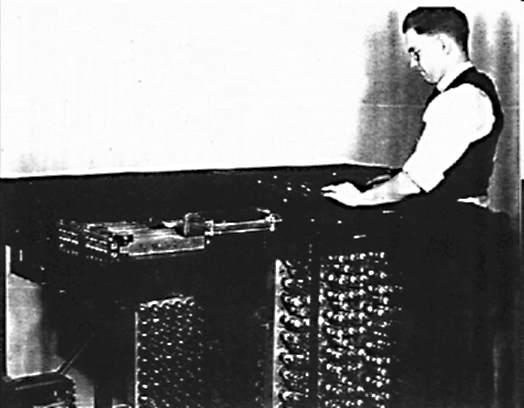| ABC - The 1st Computer? |
| Written by Historian | ||||
Page 2 of 3
B=BerryAtanasoff didn't write any of this down. He didn't have to as he never forgot an idea once he'd had it. He spent more than a year trying to perfect the jogging circuit and the binary logic elements his computer would need and then he hired someone to build it. Clifford Berry was a graduate student in Electrical Engineering recommended to Atanasoff by his good friend Harold Anderson who was Berry's professor. Anderson had been impressed by Clifford Berry's brilliance and capacity, an opinion that Atanasoff shared from their earliest encounter.
Clifford Berry (1918-1963) Atanasoff and Berry started work together on the prototype machine in Spring 1939 and had it working sufficiently by December of that year to give a demonstration to the Iowa State College officials that led to a grant of $850 to construct a full-scale machine capable of solving systems of equations. Work on that machine started before the year was over. ABCThe ABC, for Atanasoff Berry Computer, was an amazing machine. The logic used 300 valves and the memory was built using Bakelite drums roughly 8" in diameter and 11" long. Each drum had capacitors mounted on it in rows. The charge on each was read or and refreshed as the drum rotated. The storage capacity was thirty fifty-bit numbers per drum - i.e. roughly 1.5KBytes. To match the thirty-bit numbers there were thirty add/subtract units. Input was via punch cards - five 15-digit numbers per card coded in decimal. Another innovation was the use of spark storage on cards. A spark was arranged so that it could char the card at appropriate places. The carbonised patches reduced the resistance of the card so that it could be read using an simple probe.
Clifford Berry with the ABC UnpatentedThe ABC was never really a completed working computer. They abandoned the project for war work and it was never finished. The machine did work for long enough to prove the principles but not for long enough to solve any real equations. Still, having awarded a grant, Iowa State University considered the idea of taking out a patent on the machine. The deal was that Atanasoff and Berry would split the royalties with the University. For some reason, and despite pressure from Atanasoff and Berry, the University never got round to applying for the patent. Mauchly Visits AtanasoffIn December 1940 Atanasoff attended a lecture given by John Mauchly on using analogue computers. At the end he chatted with Mauchly about the alternative approach and told him all about the digital computer he was building. An invitation to view the machine was taken up a few months later when Mauchly and his son were house guests of Atanasoff for five days, see 14 June 1941 - Date of a Significant Meeting. Mauchly asked to take a copy of the documentation so that he might build an Atanasoff calculator at the Moore School of Engineering. Atanasoff declined saying that he wanted the machine to remain secret until a patent was granted. During the war Atanasoff became head of the Acoustics Division of the Naval Ordinal Lab. Mauchly and J Presper Eckert were in the same section and news reached Atanasoff that they were working on something new to do with computing. He asked what they were up to but got the reply that the subject was classified. Mauchly and Eckert were of course working on the ENIAC - the machine that is generally regarded as the first digital computer. Atanasoff himself was offered the chance to build a machine for the Navy but he felt that it would interfere with his other work which he considered more important to the war effort. After the war Atanasoff did not return to computers. He felt that he had built a working computer and had spent enough time and energy on the subject. Years later he regretted not continuing his work. He had underestimated the revolutionary nature of the computer that he had built and the impact it might have on the world. And he regretted the fact that Eckert and Mauchly got the praise for building the first electronic computer, the ENIAC, without any mention of his pioneering efforts and the ABC. Disputed PatentIn 1954 an IBM patent lawyer contacted Atanasoff with an offer to break the Mauchly-Eckert patent. The patent was owned by IBM's rivals and so destroying it would be to IBM's advantage. Atanasoff refused at first and then agreed, believing that they had a good chance of proving that he and Berry built a real computer before the ENIAC. But the pace of legal proceedings concerning patents is very slow and unfortunately Clifford Berry committed suicide in 1963 (Atanasoff has hinted several times that it might have been murder) and this lost them a key witness to the fact that the ABC had been built when Atanasoff claimed it had. The case finally came to court in 1970 and Atanasoff demonstrated a reconstruction of the machine to the judge. It clearly made a big enough impression for the decision to be made in his favour. The judgement described Atanasoff as the inventor of the electronic computer and maintained that Eckert and Mauchly had built a machine that derived from the ABC. The patent was also overturned, because ENIAC had been used on the H bomb calculations at least a year before the patent was filed. The decision was announced on October 19th, 1973 and had the bad luck to be up against the Watergate scandal for the attention of the national press. As a result what might have been a big story went virtually unreported and Atanasoff remained bitter that he didn't get the credit he deserved. |
||||
| Last Updated ( Thursday, 17 October 2024 ) |



